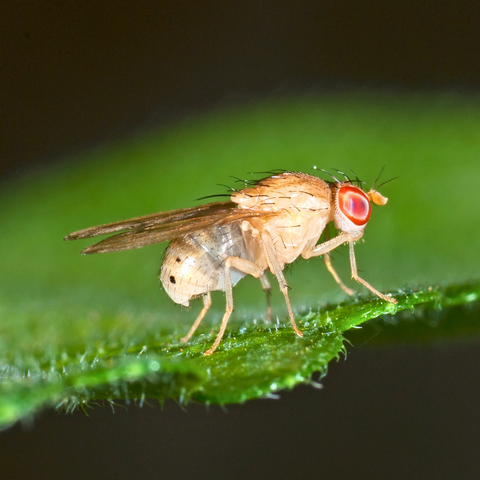First discovered in California in 2008, spotted winged drosophila became prevalent in New England by late summer 2011. The spotted wing drosophila (SWD) is an invasive pest that differs from many vinegar flies in that it lays its eggs inside fresh fruit, often before the fruit harvest.
Adult spotted winged drosophila are approximately three (3) mm long, characterized by red eyes and a tan body with dark brown bands. Adult males have a single spot on each wing, although it may be faint or missing at times. The defining characteristic in males is the existence of sex combs on each front leg, or two black patches of hair. Identifying adult female SWD is more challenging than their male counterpart. While adult females have a larger serrated ovipositor than other fruit fly species, it is only visible under a microscope. The larvae are approximately one-eighth (1/8) of an inch long and have a white, cylindrical body that tapers on one end.
SWD prefers high humidity and moderate temperatures, with adults being most active around 70°F. During the growing season, adults live for up to two months, and females can lay hundreds of eggs inside ripening fruits. In ideal conditions, a new generation may form in 10 to 20 days, allowing multiple generations to occur within a single year.
Penn State Extension states that SWD adult females can overwinter; however, SWD populations in the Northeast significantly decrease during winter, forcing spring SWD populations to begin at low levels, which allows many early-season crops to evade damage.
The emergence of SWD on your farm poses a risk of severe crop loss. It has many hosts, including brambles, blueberries, strawberries, grapes, cherries, peaches, and nectarines; we've seen it as a particular nuisance in commercial raspberry production. According to the Oregon State Extension Office, firmness and Brix level are key fruit characteristics that indicate susceptibility to SWD. An increase in sugar and a decrease in firmness escalate susceptibility to SWD damage. OSU Extension reports that when Brix level increases above 10°Brix, the probability of SWD infestation increases by over 50%. When sugar levels are below 10°Brix, the fruit skin is typically too firm for SWD to cut into the fruit to lay eggs.
Female SWD utilize their reinforced, serrated ovipositor to cut a slit into healthy fruit to lay eggs. Larvae create the most damage feeding inside the fruit. In just a few days, the fruit skin becomes dimpled and wrinkled, with craters forming on the fruit, making it more susceptible to rot and decay. Often, damage is not visible until after harvest. Damaged fruit is challenging to harvest and is commonly unmarketable.
We've seen that for many growers, control of Spotted Winged Drosophila (SWD) has driven the focus on canopy management. Ensuring proper in-row and aisle spacing, trellising plants, and maintaining cane density and vegetative growth will optimize yields, increase picking efficacy, and increase light penetration and air circulation, which can reduce pest and disease pressure.
SWD prefers to harbor in the lower canopy, and removing foliage from the lower 12–18 inches of canes in mid-summer reduces the preferred habitat and increases exposure to predators. We advocate for regular picking, sanitation, and the removal of overripe and dropped fruits to decrease pest pressure.
A cost-effective and straightforward method to determine the presence and abundance of SWD is the use of traps. To create a trap, use a large plastic cup container and fill half of it with apple cider vinegar. To allow the entry of small flies while excluding larger insects, drill quarter-inch diameter holes on the sides of the container near the top. Add a drop of unscented dish soap and hang a yellow sticky card inside to trap the flies. Place the trap within the canopy of the crop in a shaded location. Check the trap weekly and add a new sticky pad and fresh vinegar to retain attraction. Set traps before fruit ripening to document the onset of infestation.
If there is a prevalence of spotted winged drosophila on your farm, we strongly encourage you to contact your local extension office for individualized guidance and management advice.



